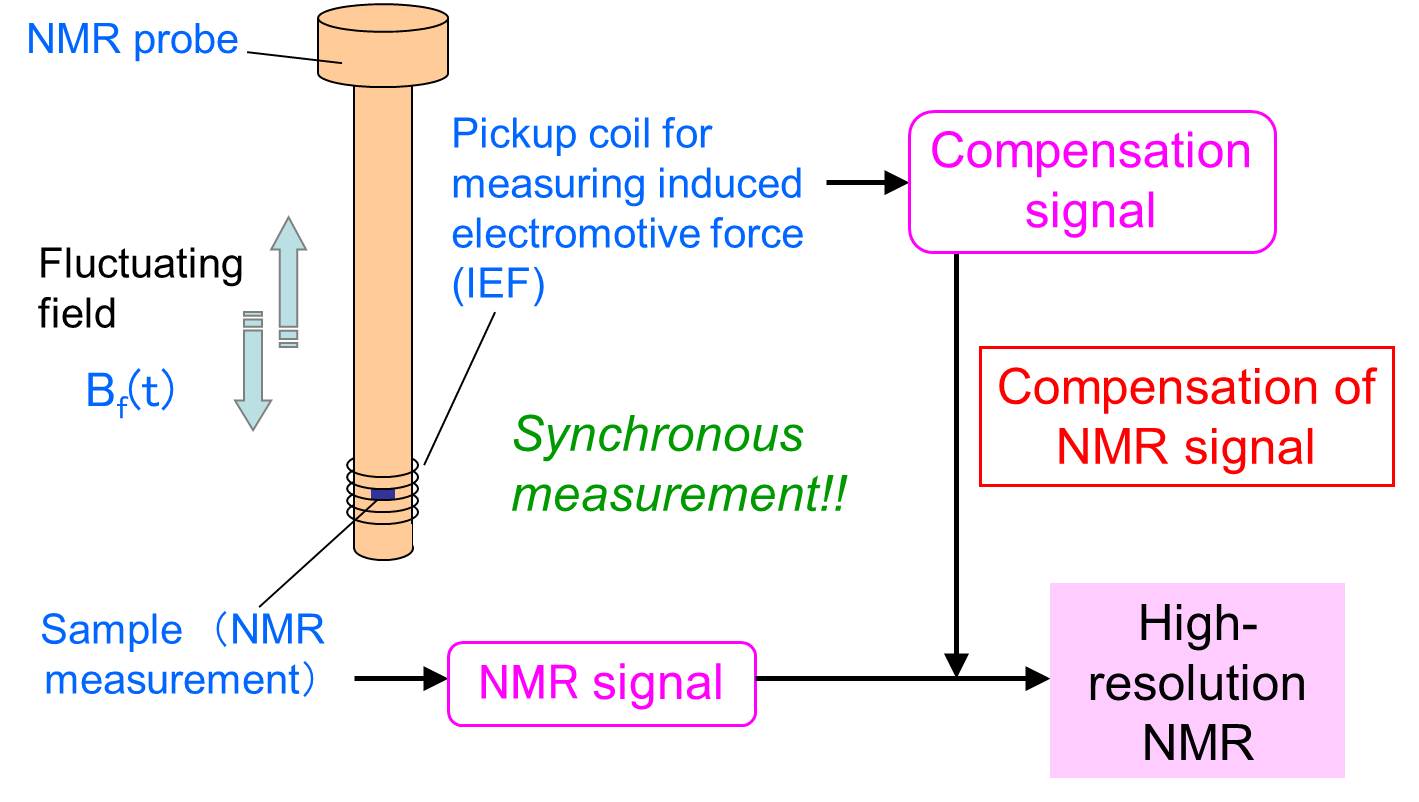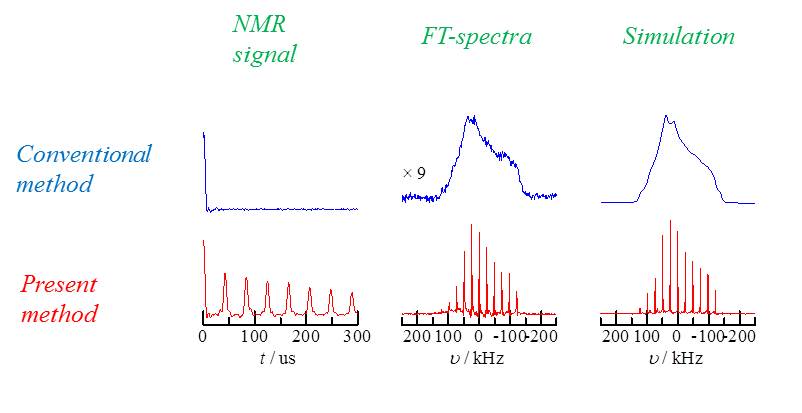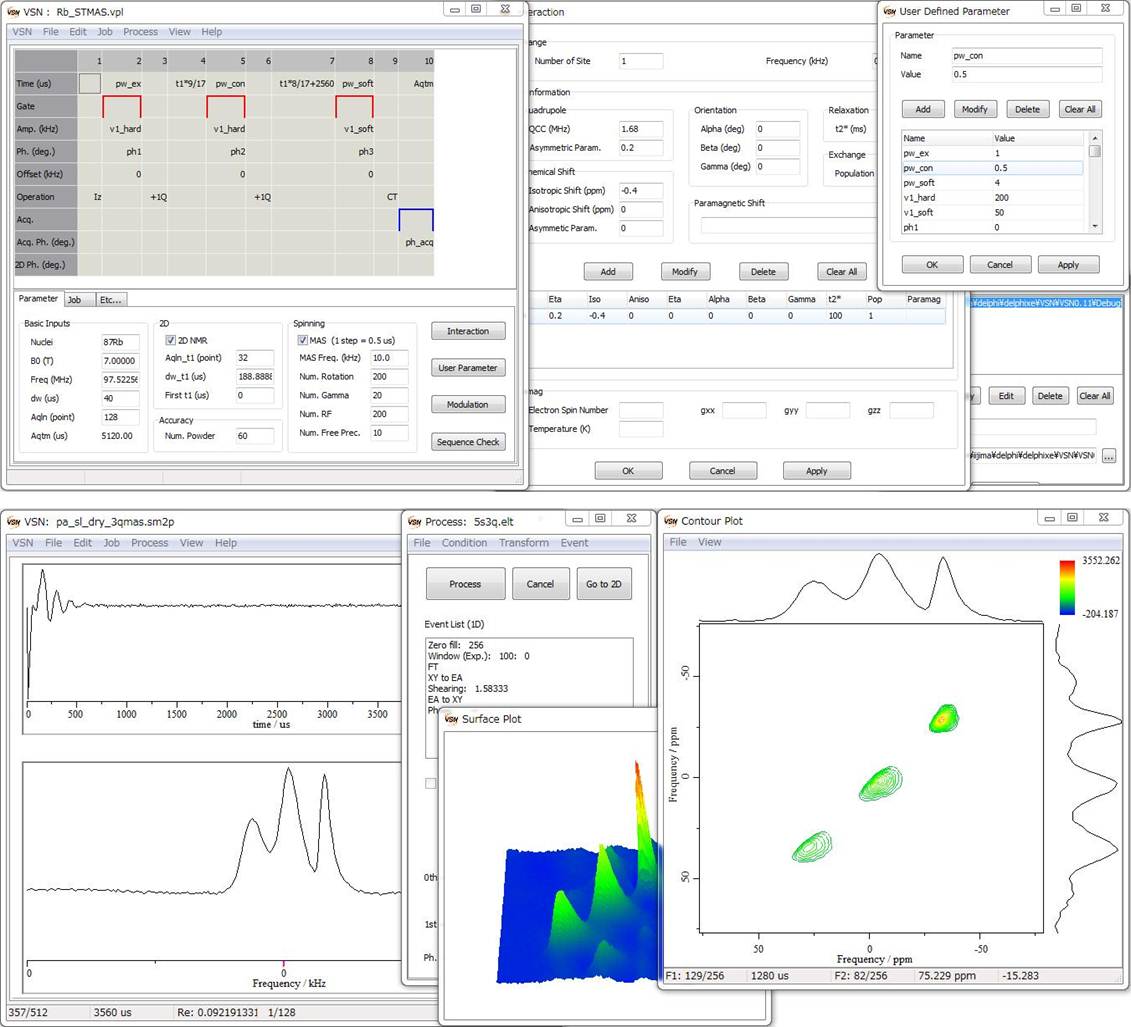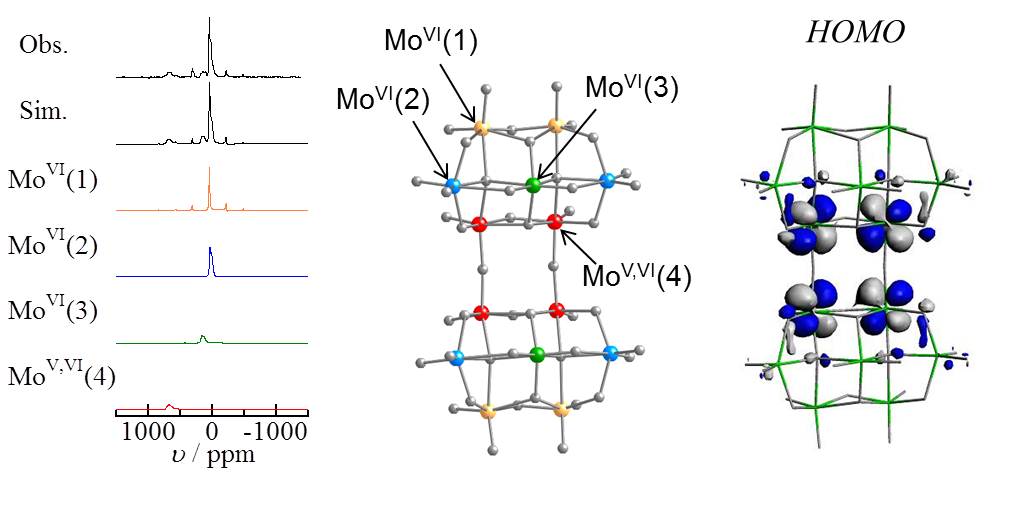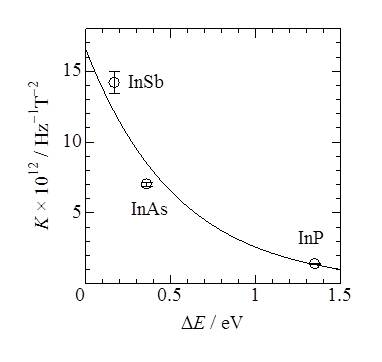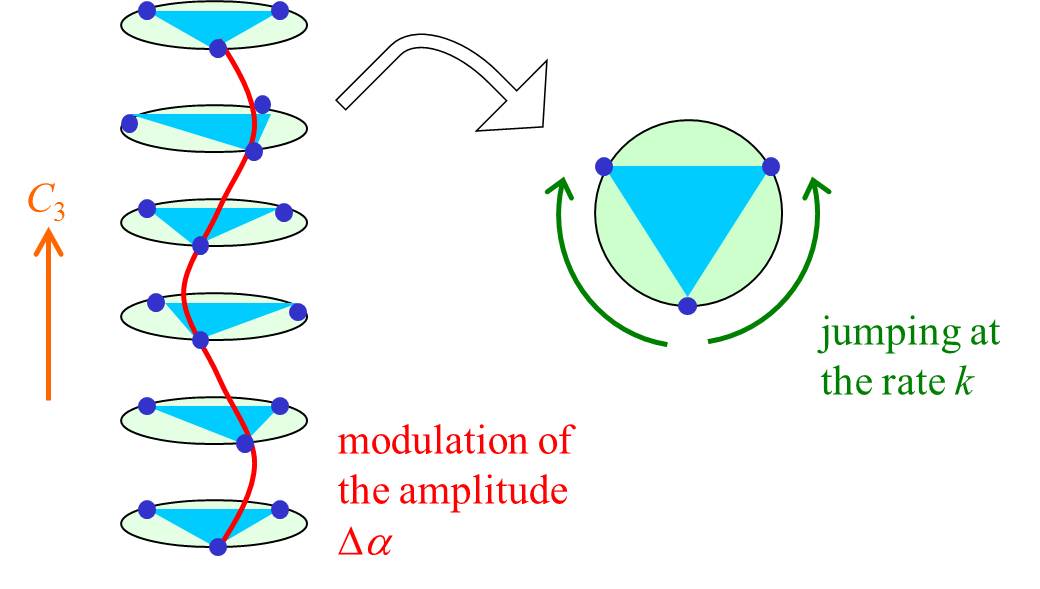My research interest focuses on development of novel nuclear-magnetic-resonance (NMR) methods and application of them and other advanced NMR techniques to solid state physics and materials science.
High resolution NMR under fluctuating magnetic field
|
Resolution and sensitivity in NMR can be increased with increasing magnetic field, because
equilibrium magnetization and chemical shift are proportional to the applied field.
There are superconducting, Bitter and hybrid magnets as a high-field NMR magnet. Although
superconducting magnets with considerably stable field are used for high-resolution NMR in most
cases, the strength is 22-23 T at most. NMR measurement with field up to 58 T has been performed by
employing pulsed magnets. High-resolution NMR, however, is difficult to be measured with
the hybrid magnet, because the field sustains only of the order of ms and homogeneity and stability
are insufficient for NMR measurement. Thus the Bitter and hybrid magnets with the field up to about
45 T sustaining more than an hour are major candidates for high-resolution NMR. Unfortunately the
conventional measurement cannot provide high-resolution spectra, because these magnets also exhibit
field fluctuation.
We have suggested and demonstrated two different methods that are able to measure high-resolution NMR under field fluctuation. In these methods, field-fluctuation components are compensated by signals of (1) induced electromotive force (IEF) generated in a pickup coil wound around a NMR probe (Fig. 1) or (2) NMR of a reference channel, that are measured synchronously with NMR for observation. By these methods, we can measure high resolution NMR with the Bitter or hybrid magnet for samples from solution to solid.
Fig. 1: Schematic diagram of compensation of field fluctuation (J. Magn. Reson. 184, 258 (2007)).
|
High-sensitivity deuterium NMR for paramagnetic solids
|
Inherently low sensitivity is a drawback of NMR, even though we can obtain valuable information
from it. Quadrupolar Carr-Purcell-Meiboom-Gill (QCPMG) is a method to improve the signal-to-noise
ratio of NMR spectra of quadrupole nuclei that has nuclear spin I > 1/2 by repeating irradiation of
radio frequency (rf) pulses and acquisition of spin-echo signals. For deuterium (2H, I =
1) NMR of paramagnetic solids, however, the conventional QCPMG method cannot generate successive
spin-echo correctly, because the hyperfine interaction from paramagnetic ions as well as the
quadrupole interaction affect nuclear-spin dynamics.
In the present study, we developed a pulse sequence that can repeatedly refocus magnetization
dephased both by the quadrupole and hyperfine interactions. Strong and short radio-frequency (rf)
pulses are needed for this sequence to work, because the deuterium NMR spectra are broadened by the
large quadrupole interaction with the size of 100-200 kHz. In order to irradiate strong rf pulses,
we adopted a small solenoid coil in a rf circuit of the NMR probe.
Fig. 2 shows the result of the present method demonstrated using paramagnetic crystals. The intensity of the spectrum varies with pulse duration in the sequence. In this figure, the signal-to-noise ratio was increased by about 9 times with using the QCPMG technique. We also measured temperature dependence of the spectra to investigate detection ability of molecular motion. It was found that the region of molecular motion sensitive to the spectra was extended by the present method. This shows that the present QCPMG method has an advantage over the conventional method in the analysis of molecular motion.
Fig. 2: Comparison of 2H NMR for paramagnetic crystals. Upper: conventional method; Lower: present method (Chem. Phys. Lett. 514, 181 (2011)).
|
Software for analysis of solid state NMR
|
Valuable information about static and dynamic local structure and electron structure of molecules
are included in the tensor of nuclear spin interactions such as a chemical shift. Although the
tensor is averaged out in solution by fast isotropic motions in ordinary cases, we can extract it
in solid state NMR where motions are constrained. However, this also means that the measurement and
analysis of solid state NMR are complicated. In particular, lineshape analysis is needed in case of
half-integer quadrupole nuclei to obtain the NMR parameters from NMR spectra, because the spectra
are inhomogeneously broadened by the quadrupole interaction, even though the magic angle spinning
(MAS) technique is used.
In the present work, I developed a software called VSN that simulates nuclear spin dynamics for multiple level systems (Fig. 3). By changing the setting of the program, time evolution of spin system is calculated for central (|1/2>⇔-|1/2>) and satellite (±|m/2>⇔±|n/2>) transitions and multiple quantum coherence (|m/2>⇔-|m/2>) with considering several effects like MAS, multiple pulses and molecular motion. Further, data processing functions such as one- and two-dimensional Fourier transform and shearing transform are added in VSN.
Fig. 3: Screen shot of the software VSN.
|
Structural analysis of inorganic materials by high field NMR and quantum chemical calculation
|
Recent development of NMR magnets enables us to measure high-field high-resolution NMR of solids.
In particular, half-integer quadrupole nuclei benefit from it, because higher fields bring
improved resolution caused by reduction of the second-order quadrupole interaction and enhanced
sensitivity due to increase of equilibrium magnetization.
Giant polyoxometalates (POMs) fabricated by photoreduction of small sized POMs have attracted attention because of the interesting properties. The reduced electrons of metal in mixed valence states are considered to correlate with the molecular structure and solid state physics of the giant POMS. We have investigated localization of d-electrons for some polyoxomolybdates by high-field molybdenum (95Mo, I = 5/2) NMR and quantum chemical calculation (Fig. 4). We also studied the amorphous structure of inorganic materials of porous alumina and AlPO4 by high-field aluminium (27Al, I = 5/2) NMR and 27Al-31P correlation NMR. The structure of duplex oxide layer of the porous alumina and inhomogeneous distribution of Al-O-Al bond angles of AlPO4 were clarified.
Fig. 4: 95Mo NMR, molecular structure, and HOMO for {Mo14} (Chem. Phys. Lett. 487, 232 (2010)).
|
Indirect nuclear spin coupling of semiconductors studied by high-resolution solid-state NMR
|
Quantum computers can perform a certain type of calculation drastically faster than classical
computers do. Although at least several quantum bits (qubits) are needed for meaningful
calculation, only seven qubits have been achieved yet. Recently, solid-state NMR quantum computers
operated on semiconductors have been proposed as a multiple qubit system. Although some of them
use indirect nuclear spin coupling (J coupling) for the controlled NOT gate, studies about the J
coupling have been insufficient. In this work, we estimated the value of the J coupling by
measuring high-resolution solid-state NMR of III-V compound semiconductors of InX (X = P, As, Sb).
The larger J value between nearest In-X was found to be obtained for narrower bandgap of the
semiconductors (Fig. 5). Further, the J coupling of the n- or p-type semiconductor with large
carrier concentration was found to be unobservable owing to spectral broadening by the hyperfine
interaction. This shows that the semiconductor with small impurity concentration is required as a
device material of the NMR quantum computer.
Fig. 5: Bandgap dependence on the reduced coupling constant of the indirect nuclear spin interaction in InX (X = P, As, Sb) (Jpn. J. Appl. Phys. 45, 651 (2006)).
|
Molecular dynamics and structural phase transition of [M(H2O)6]AB6] studied by solid state NMR
|
Analysis of orientation, packing and dynamics of molecules is important to reveal origins of
physical properties of solids, because many of macroscopic properties are correlated with local
structures. Solid-state NMR is an efficient method to obtain information about static and dynamic
local structures. We applied solid state NMR to investigate solid state physics of
[M(H2O)6]AB6] (M = Mg2+, Mn2+,
Fe2+, Co2+, Ni2+, Cu2+; AB6 =
PtCl6, SiF6). The properties of these crystals differ by the type of the
central metal ion. [M(H2O)6][SiF6] other than that with M =
Ni2+ undergo structural phase transitions by order-disorder of the
[M(H2O)6]2+ and [SiF6]2- ions.
From simulation analysis of 2H NMR spectra (Fig. 6), the order-disorder transition was
found to be correlated with freeze of motion of [M(H2O)6]2+.
[Cu(H2O)6][PtCl6] undergoes a structural phase transition by
cooperative Jahn-Teller effect. The lower shift of transition temperature on deuteration was found
to be caused not by mass effect but by a weakening of the hydrogen bond of O-H...Cl.
Fig. 6: Model structure for simulation of 2H NMR in case of coexistence of the molecular modulation and motion (Chem. Phys. Lett. 380, 736 (2003)).
|



